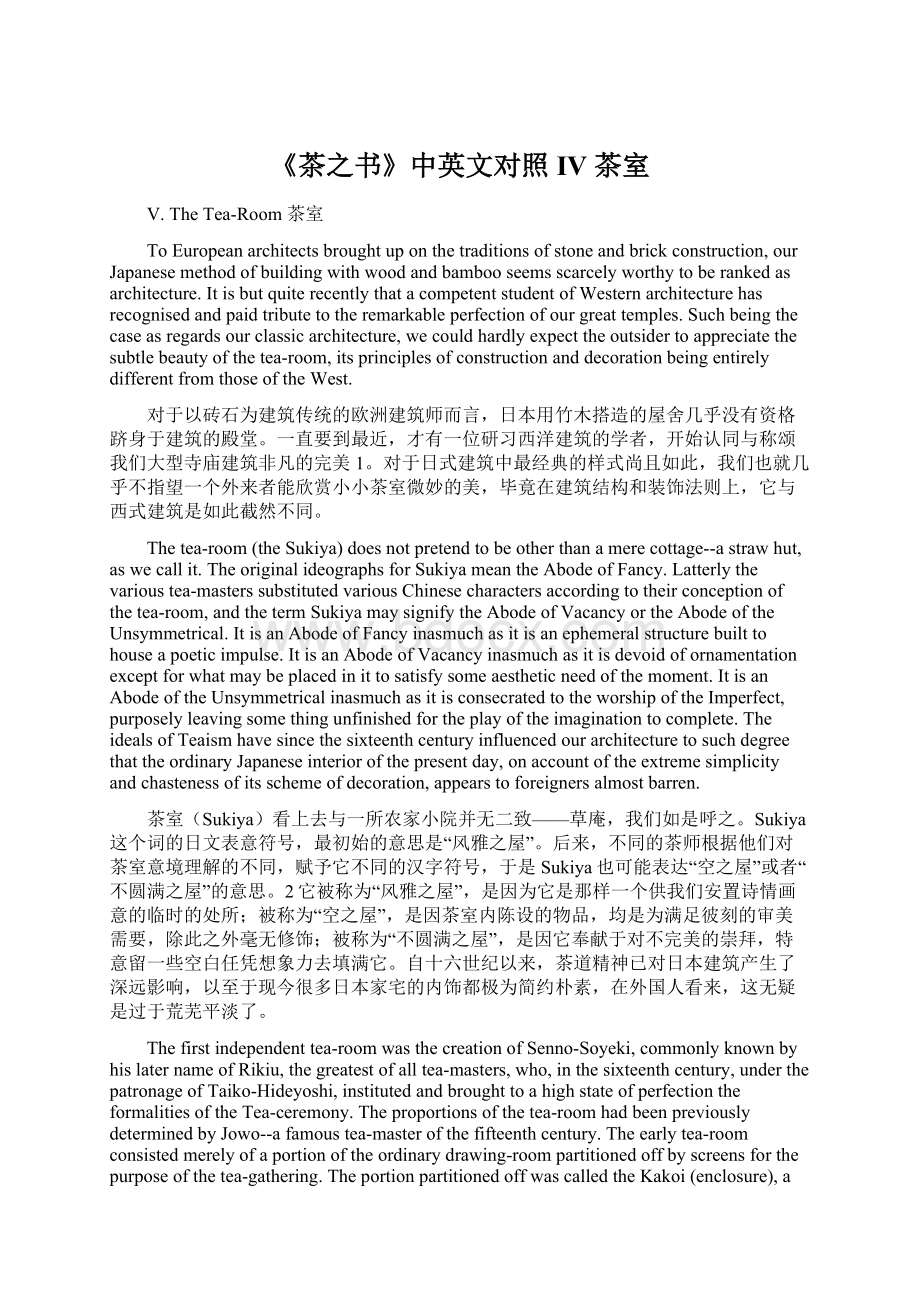《茶之书》中英文对照 IV 茶室文档格式.docx
《《茶之书》中英文对照 IV 茶室文档格式.docx》由会员分享,可在线阅读,更多相关《《茶之书》中英文对照 IV 茶室文档格式.docx(11页珍藏版)》请在冰豆网上搜索。

Thetea-room(theSukiya)doesnotpretendtobeotherthanamerecottage--astrawhut,aswecallit.TheoriginalideographsforSukiyameantheAbodeofFancy.Latterlythevarioustea-masterssubstitutedvariousChinesecharactersaccordingtotheirconceptionofthetea-room,andthetermSukiyamaysignifytheAbodeofVacancyortheAbodeoftheUnsymmetrical.ItisanAbodeofFancyinasmuchasitisanephemeralstructurebuilttohouseapoeticimpulse.ItisanAbodeofVacancyinasmuchasitisdevoidofornamentationexceptforwhatmaybeplacedinittosatisfysomeaestheticneedofthemoment.ItisanAbodeoftheUnsymmetricalinasmuchasitisconsecratedtotheworshipoftheImperfect,purposelyleavingsomethingunfinishedfortheplayoftheimaginationtocomplete.TheidealsofTeaismhavesincethesixteenthcenturyinfluencedourarchitecturetosuchdegreethattheordinaryJapaneseinteriorofthepresentday,onaccountoftheextremesimplicityandchastenessofitsschemeofdecoration,appearstoforeignersalmostbarren.
茶室(Sukiya)看上去与一所农家小院并无二致——草庵,我们如是呼之。
Sukiya这个词的日文表意符号,最初始的意思是“风雅之屋”。
后来,不同的茶师根据他们对茶室意境理解的不同,赋予它不同的汉字符号,于是Sukiya也可能表达“空之屋”或者“不圆满之屋”的意思。
2它被称为“风雅之屋”,是因为它是那样一个供我们安置诗情画意的临时的处所;
被称为“空之屋”,是因茶室内陈设的物品,均是为满足彼刻的审美需要,除此之外毫无修饰;
被称为“不圆满之屋”,是因它奉献于对不完美的崇拜,特意留一些空白任凭想象力去填满它。
自十六世纪以来,茶道精神已对日本建筑产生了深远影响,以至于现今很多日本家宅的内饰都极为简约朴素,在外国人看来,这无疑是过于荒芜平淡了。
Thefirstindependenttea-roomwasthecreationofSenno-Soyeki,commonlyknownbyhislaternameofRikiu,thegreatestofalltea-masters,who,inthesixteenthcentury,underthepatronageofTaiko-Hideyoshi,institutedandbroughttoahighstateofperfectiontheformalitiesoftheTea-ceremony.Theproportionsofthetea-roomhadbeenpreviouslydeterminedbyJowo--afamoustea-masterofthefifteenthcentury.Theearlytea-roomconsistedmerelyofaportionoftheordinarydrawing-roompartitionedoffbyscreensforthepurposeofthetea-gathering.TheportionpartitionedoffwascalledtheKakoi(enclosure),anamestillappliedtothosetea-roomswhicharebuiltintoahouseandarenotindependentconstructions.TheSukiyaconsistsofthetea-roomproper,designedtoaccomodatenotmorethanfivepersons,anumbersuggestiveofthesaying"
morethantheGracesandlessthantheMuses,"
ananteroom(midsuya)wheretheteautensilsarewashedandarrangedbeforebeingbroughtin,aportico(machiai)inwhichtheguestswaituntiltheyreceivethesummonstoenterthetea-room,andagardenpath(theroji)whichconnectsthemachiaiwiththetea-room.Thetea-roomisunimpressiveinappearance.ItissmallerthanthesmallestofJapanesehouses,whilethematerialsusedinitsconstructionareintendedtogivethesuggestionofrefinedpoverty.Yetwemustrememberthatallthisistheresultofprofoundartisticforethought,andthatthedetailshavebeenworkedoutwithcareperhapsevengreaterthanthatexpendedonthebuildingoftherichestpalacesandtemples.Agoodtea-roomismorecostlythananordinarymansion,fortheselectionofitsmaterials,aswellasitsworkmanship,requiresimmensecareandprecision.Indeed,thecarpentersemployedbythetea-mastersformadistinctandhighlyhonouredclassamongartisans,theirworkbeingnolessdelicatethanthatofthemakersoflacquercabinets.
第一个独立的茶室由千宗易创建,也就是后来广为人知的利休3,他堪称茶道大师中的大师。
十六世纪时,在丰臣秀吉4的资助下,他将茶道的基本仪式固定下来,并将其领入一个至臻至美的境界。
在此之前,茶室的格局,已由十五世纪的著名茶师武野绍欧5所确定。
早期的茶室,常常是只为了茶会的需要,将一间普通客堂用屏风隔出一块区域,供饮茶待客之用。
这样的隔间叫做“围室”(Kakoi),至今这个名字在室内非独立茶室中仍在使用。
而独立的数寄屋,则由茶室本身、水屋、门廊和露地几个部分组成。
茶室本身是按照容纳不超过五个人的标准设计的,正合了那句“比美惠三女神多,比缪斯九女神少”6的谚语;
水屋,是在上茶之前洗净与摆放茶具之地;
门廊,是客人们在主人召唤进入茶室之前的等候区域;
露地,则是连接着门廓和茶室的庭院小径。
整个茶室从外表看毫无惊艳之处。
它的大小比不上日本最普通的家宅,它所用的建筑材质,意欲暗示一种高贵的清贫。
然而我们必须记住,这一切表面示现的背后,是艺术构思的深思熟虑。
茶室所有细处被精心安排的程度,绝不亚于任何富丽堂皇的宫殿与庙宇。
一座理想茶室的造价,可能比一所普通的豪宅更为昂贵,因为从建材选择到建筑施工,皆需具备极大的审慎与精细。
事实上,被茶师选中的木匠,形成了工匠中最为出色且备受尊崇的阶层,他们手艺的精细程度,即便与漆器工匠相比也毫不逊色。
Thetea-roomisnotonlydifferentfromanyproductionofWesternarchitecture,butalsocontrastsstronglywiththeclassicalarchitectureofJapanitself.Ourancientnobleedifices,whethersecularorecclesiastical,werenottobedespisedevenasregardstheirmeresize.Thefewthathavebeensparedinthedisastrousconflagrationsofcenturiesarestillcapableofaweingusbythegrandeurandrichnessoftheirdecoration.Hugepillarsofwoodfromtwotothreefeetindiameterandfromthirtytofortyfeethigh,supported,byacomplicatednetworkofbrackets,theenormousbeamswhichgroanedundertheweightofthetile-coveredroofs.Thematerialandmodeofconstruction,thoughweakagainstfire,proveditselfstrongagainstearthquakes,andwaswellsuitedtotheclimaticconditionsofthecountry.IntheGoldenHallofHoriujiandthePagodaofYakushiji,wehavenoteworthyexamplesofthedurabilityofourwoodenarchitecture.Thesebuildingshavepracticallystoodintactfornearlytwelvecenturies.Theinterioroftheoldtemplesandpalaceswasprofuselydecorated.IntheHoodotempleatUji,datingfromthetenthcentury,wecanstillseetheelaboratecanopyandgildedbaldachinos,many-colouredandinlaidwithmirrorsandmother-of-pearl,aswellasremainsofthepaintingsandsculpturewhichformerlycoveredthewalls.Later,atNikkoandintheNijocastleinKyoto,weseestructuralbeautysacrificedtoawealthofornamentationwhichincolourandexquisitedetailequalstheutmostgorgeousnessofArabianorMoorisheffort.
茶室不仅与西方建筑区别甚大,即便与本国的经典建筑相比也大相径庭。
日本古代的尊贵建筑,无论是殿堂宅邸还是庙宇神社,仅在建筑规模上就无法让人小觑。
那些从数世纪火灾的风险中幸存下来的少数建筑,其外观的庄严盛大与内部的富丽堂皇仍能让我们心生敬畏。
直径两三英尺,高三四十英尺的巨大木柱,通过结构复杂精妙的建筑支架,撑起在屋瓦的重压下嘎吱作响的巨大横梁。
整个建筑材质和建筑结构虽不利于防火,却足够坚固抵挡地震,也与本地气候条件相适应。
法隆寺7的金堂以及药师寺8的佛塔,都已原封不动地伫立了近十二个世纪,是木建筑坚固耐久的明证。
这些古寺和宫殿的装潢都极度奢华。
在建于公元十世纪的宇治凤凰堂9,我们仍可看到色彩繁复的精致华盖和镀金的龛室,明镜与螺钿镶嵌其中,也可以看到精美的雕塑以及曾满覆墙面的残存绘画。
而稍晚时候的建筑,如日光城10和京都二条城11,我们可以领略到,结构的宏观之美是如何让位于近似于阿拉伯或摩尔式建筑那卓绝辉煌的、富于色彩与繁复细节的装饰。
Thesimplicityandpurismofthetea-roomresultedfromemulationoftheZenmonastery.AZenmonasterydiffersfromthoseofotherBuddhistsectsinasmuchasitismeantonlytobeadwellingplaceforthemonks.Itschapelisnotaplaceofworshiporpilgrimage,butacollegeroomwherethestudentscongregatefordiscussionandthepracticeofmeditation.Theroomisbareexceptforacentralalcoveinwhich,behindthealtar,isastatueofBodhiDharma,thefounderofthesect,orofSakyamuniattendedbyKaphiapaandAnanda,thetwoearliestZenpatriarchs.Onthealtar,flowersandincenseareofferedupinthememoryofthegreatcontributionswhichthesesagesmadetoZen.WehavealreadysaidthatitwastheritualinstitutedbytheZenmonksofsuccessivelydrinkingteaoutofabowlbeforetheimageofBodhiDharma,whichlaidthefoundationsofthetea-ceremony.WemightaddherethatthealtaroftheZenchapelwastheprototypeoftheTokonoma,--theplaceofhonourinaJapaneseroomwherepaintingsandflowersareplacedfortheedificationoftheguests.
茶室简约与纯粹的风格源自对禅寺的仿效。
与佛教其它宗派的寺院不同,禅寺仅仅是供僧人居住之用。
禅院并不是参拜与朝圣的道场,而是佛子禅辩和打坐的学堂。
禅堂空阔,除了祭台后面的中央神龛以外别无他物。
神龛里供奉的,往往是禅宗祖师菩提达摩的塑像,或者是释迦牟尼及其侍者迦叶与阿难的塑像。
祭台上摆放着供养的香花,以纪念这些大德对禅门所做的卓绝贡献。
我们已经说过,在达摩像前依次共碗饮茶,是禅宗的和尚们所创建的仪式,这已成为今日茶道的起源。
在这里需要补充的是,壁龛(Tokomoma,床之间)的原型其实来源于禅堂的祭台。
壁龛是日本房间里最尊贵之处,常常以插花与绘画装点,供客人陶冶情操之用。
Allourgreattea-masterswerestudentsofZenandattemptedtointroducethespiritofZennismintotheactualitiesoflife.Thustheroom,liketheotherequipmentsofthetea-ceremony,reflectsmanyoftheZendoctrines.Thesizeoftheorthodoxtea-room,whichisfourmatsandahalf,ortenfeetsquare,isdeterminedbyapassageintheSutraofVikramadytia.Inthatinterestingwork,VikramadytiawelcomestheSaintManjushiriandeighty-fourthousanddisciplesofBuddhainaroomofthissize,--anallegorybasedonthetheoryofthenon-existenceofspacetothetrulyenlightened.Againtheroji,thegardenpathwhichleadsfromthemachiaitothetea-room,signifiedthefirststageofmeditation,--thepassageintoself-illumination.Therojiwasintendedtobreakconnectionwiththeoutsideworld,andproduceafreshsensationconducivetothefullenjoymentofaestheticisminthetea-roomitself.Onewhohastroddenthisgardenpathcannotfailtorememberhowhisspirit,ashewalkedinthetwilightofevergreensovertheregularirregularitiesofthesteppingstones,beneathwhichlaydriedpineneedles,andpassedbesidethemoss-coveredgranitelanterns,becameupliftedaboveordinarythoughts.Onemaybeinthemidstofacity,andyetfeelasifhewereintheforestfarawayfromthedustanddinofcivilisation.Greatwastheingenuitydisplayedbythetea-mastersinproducingtheseeffectsofserenityandpurity.Thenatureofthesensationstobearousedinpassingthroughtherojidifferedwithdifferenttea-masters.Some,likeRikiu,aimedatutterloneliness,andclaimedthesecretofmakingarojiwascontainedintheancientditty:
"
Ilookbeyond;
/Flowersarenot,/Nortintedleaves./Ontheseabeach/Asolitarycottagestands/Inthewaninglight/Ofanautumneve."
所有伟大的茶师都是禅的弟子,他们尝试将禅的精神引入生活的实践。
于是茶室,以及茶室中所用的茶道器皿,皆反映了一定的禅宗教义。
正统茶室的规格为四叠半榻榻米,大约在十平方英尺,这个规定源自《维摩诘经》12中的一段故事。
在